Files in this item
Examining geodetic glacier mass balance in the eastern Pamir transition zone
Item metadata
| dc.contributor.author | Lv, Mingyang | |
| dc.contributor.author | Quincey, Duncan J. | |
| dc.contributor.author | Guo, Huadong | |
| dc.contributor.author | King, Owen | |
| dc.contributor.author | Liu, Guang | |
| dc.contributor.author | Yan, Shiyong | |
| dc.contributor.author | Lu, Xiancai | |
| dc.contributor.author | Ruan, Zhixing | |
| dc.date.accessioned | 2020-09-09T14:30:02Z | |
| dc.date.available | 2020-09-09T14:30:02Z | |
| dc.date.issued | 2020-08-03 | |
| dc.identifier | 269925998 | |
| dc.identifier | d58de895-7f65-407b-84f6-2b7a69096e1a | |
| dc.identifier | 85089741419 | |
| dc.identifier | 000592212900004 | |
| dc.identifier.citation | Lv , M , Quincey , D J , Guo , H , King , O , Liu , G , Yan , S , Lu , X & Ruan , Z 2020 , ' Examining geodetic glacier mass balance in the eastern Pamir transition zone ' , Journal of Glaciology , vol. First View . https://doi.org/10.1017/jog.2020.54 | en |
| dc.identifier.issn | 0022-1430 | |
| dc.identifier.uri | https://hdl.handle.net/10023/20594 | |
| dc.description | This research was supported by the Key Research Program of Frontier Sciences CAS [QYZDY-SSW-DQC026] and the National Natural Science Foundation of China [41590853]. SRTM DEM and NASA HMA DEM data were sourced from NASA Earthdata (https://earthdata.nasa.gov/), and the ALOS Global Digital Surface Model (AW3D30) was sourced from JAXA (https://www.eorc.jaxa.jp/ALOS/en/aw3d30/index.htm). ALOS PRISM level-1B1 products were ordered from http://en.alos-pasco.com/alos/prism/ under a 4th ALOS RA data grant awarded to Quincey (PI No. 1008). Landsat-7 and Landsat-8 images can be freely downloaded from http://glovis.usgs.gov. Randolph Glacier Inventory data were acquired from Global Land Ice Measurements from Space (GLIMS) (RGI Consortium, 2017). Lv acknowledges program B for outstanding PhD candidates of Nanjing University and the support from the Chinese Scholarship Council (CSC) for studying at the University of Leeds. | en |
| dc.description.abstract | Glaciers in the eastern Pamir have reportedly been gaining mass during recent decades, even though glaciers in most other regions in High Mountain Asia have been in recession. Questions still remain about whether the trend is strengthening or weakening, and how far the positive balances extend into the eastern Pamir. To address these gaps, we use three different digital elevation models to reconstruct glacier surface elevation changes over two periods (2000–09 and 2000–15/16). We characterize the eastern Pamir as a zone of transition from positive to negative mass balance with the boundary lying at the northern end of Kongur Tagh, and find that glaciers situated at higher elevations are those with the most positive balances. Most (67% of 55) glaciers displayed a net mass gain since the 21st century. This led to an increasing regional geodetic glacier mass balance from −0.06 ± 0.16 m w.e. a−1 in 2000–09 to 0.06 ± 0.04 m w.e. a−1 in 2000–15/16. Surge-type glaciers, which are prevalent in the eastern Pamir, showed fluctuations in mass balance on an individual scale during and after surges, but no statistical difference compared to non-surge-type glaciers when aggregated across the region. | |
| dc.format.extent | 11 | |
| dc.format.extent | 2084641 | |
| dc.language.iso | eng | |
| dc.relation.ispartof | Journal of Glaciology | en |
| dc.subject | Digital elevation model | en |
| dc.subject | Eastern Pamir | en |
| dc.subject | Glacier mass balance | en |
| dc.subject | Surge-type glaciers | en |
| dc.subject | G Geography (General) | en |
| dc.subject | Earth-Surface Processes | en |
| dc.subject | DAS | en |
| dc.subject.lcc | G1 | en |
| dc.title | Examining geodetic glacier mass balance in the eastern Pamir transition zone | en |
| dc.type | Journal article | en |
| dc.contributor.institution | University of St Andrews. School of Geography & Sustainable Development | en |
| dc.identifier.doi | https://doi.org/10.1017/jog.2020.54 | |
| dc.description.status | Peer reviewed | en |
This item appears in the following Collection(s)
Items in the St Andrews Research Repository are protected by copyright, with all rights reserved, unless otherwise indicated.

